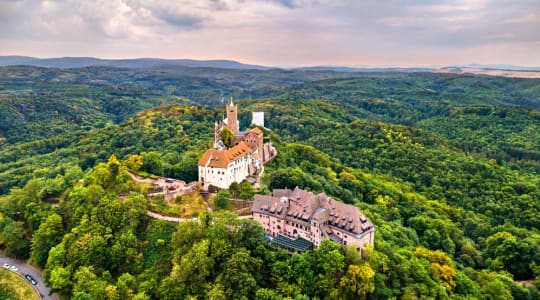Wartburg Castle is a medieval castle situated on a hill above the town of Eisenach in the German state of Thuringia. The castle was built in the 11th century and was the residence of the landgrave of Thuringia. It is best known as the place where Martin Luther translated the New Testament of the Bible into German during his exile in 1521.
The castle has a long and varied history. It was besieged and damaged during the Peasants' War in 1525 and the Thirty Years' War in the 17th century. In the 19th century, it was restored by Duke Ernst I of Saxe-Coburg and Gotha in the Gothic Revival style, and it became a popular tourist destination.
Wartburg Castle is a UNESCO World Heritage Site and is considered to be one of the best-preserved and most significant medieval castles in Germany. The castle features a mix of architectural styles from various periods, including Romanesque, Gothic, Renaissance, and Baroque.
The castle's most famous room is the Lutherstube, where Martin Luther is said to have completed his translation of the New Testament into German. Other notable features of the castle include the Great Hall, the Romanesque Palace, the Chapel of St. Elisabeth, and the Knight's Hall.
Wartburg Castle is also associated with the legend of the German knight and poet Wolfram von Eschenbach, who is said to have written his epic poem Parzival while staying at the castle. Today, the castle is open to the public, and visitors can take guided tours of the castle and its grounds.
Explore Near Wartburg castle
Discover 4 attractions, 5 cities, and 1 airport within 75km. Perfect for planning day trips, finding connecting flights, or discovering new destinations to explore during your visit.
Nearby Attractions & Places to Visit
4 destinations within 73.0km - 74.7km from your location




Nearby Cities Worth Exploring
5 destinations within 51.0km - 71.6km from your location
Airports Near Wartburg castle
1 destination within 45.6km from your location
Cross-Border Adventures Near Wartburg castle
Discover cross-border adventures near Wartburg castle. Explore neighboring countries with similar attractions and extend your travel experience across borders.








And 1 more neighboring countries
